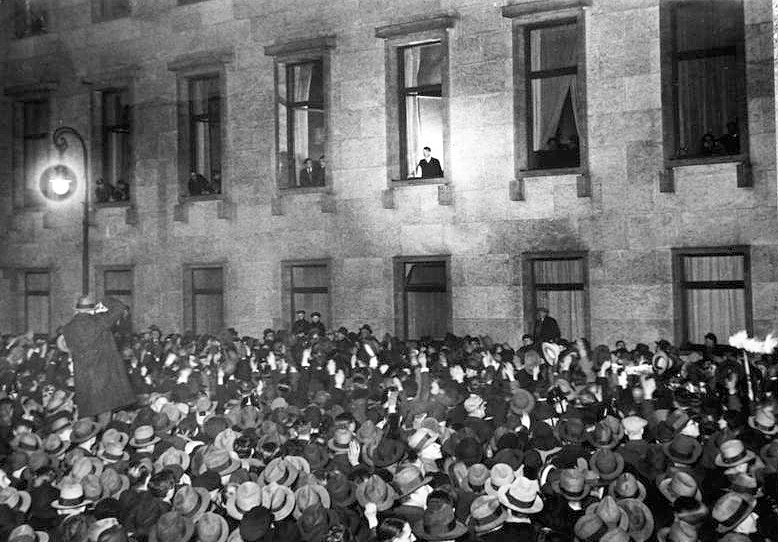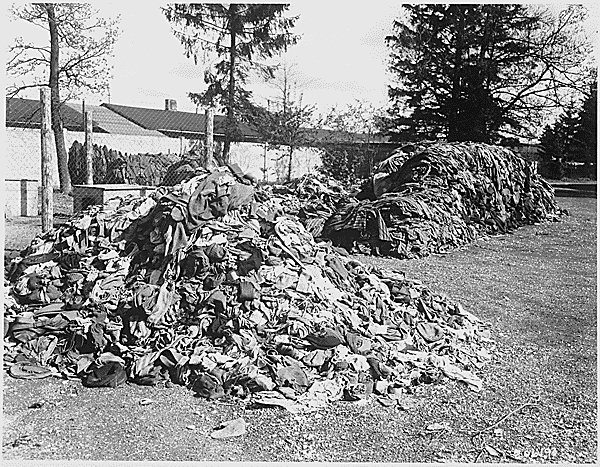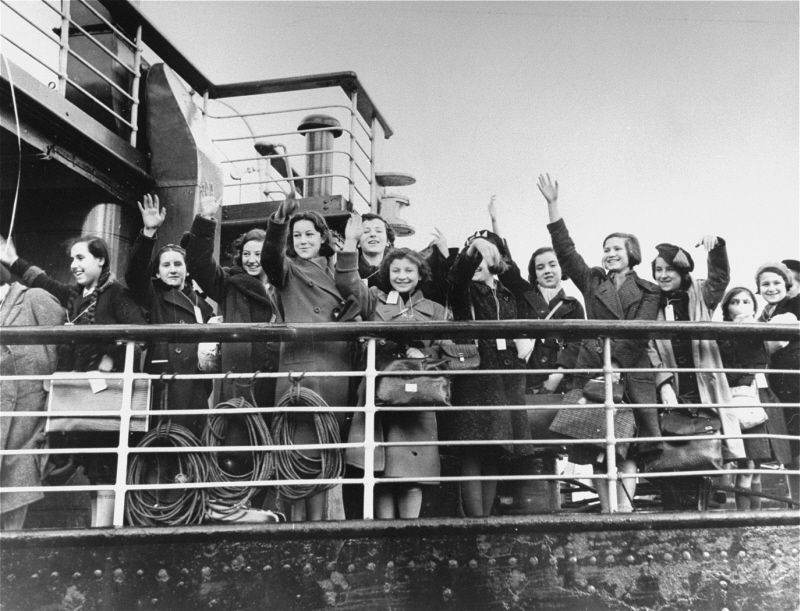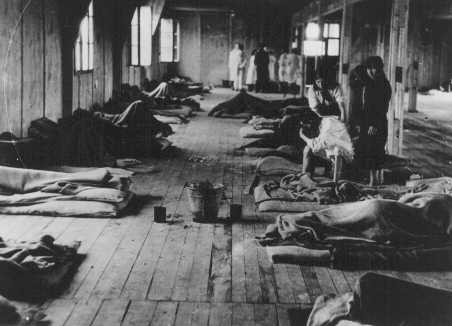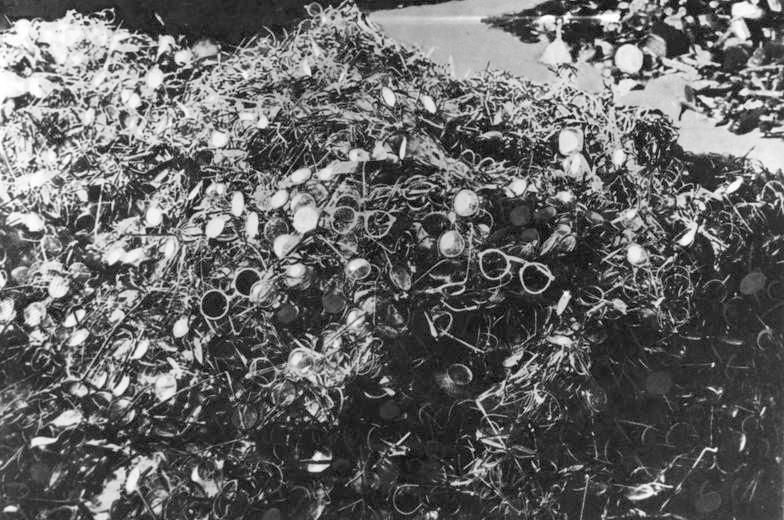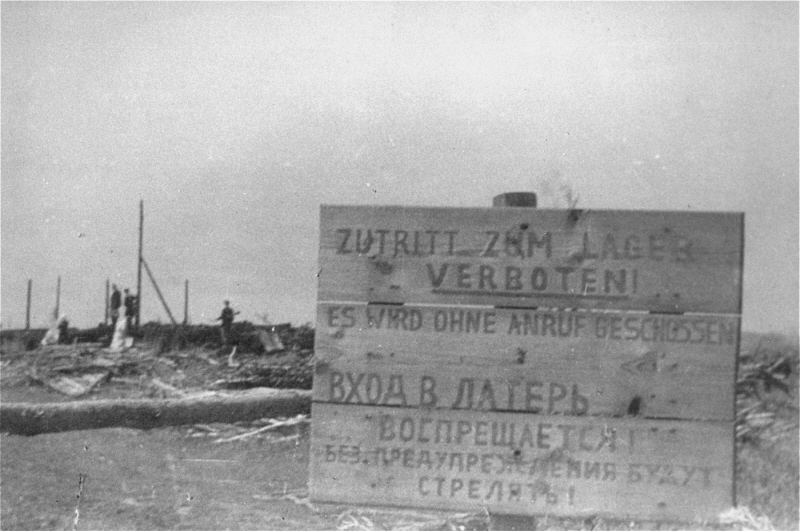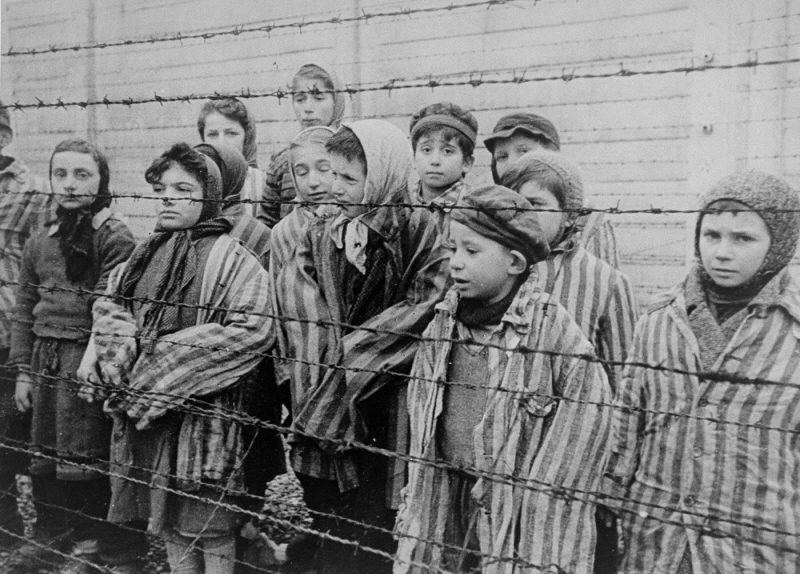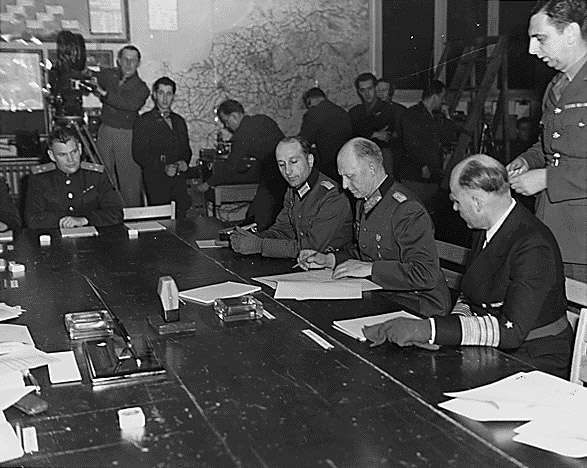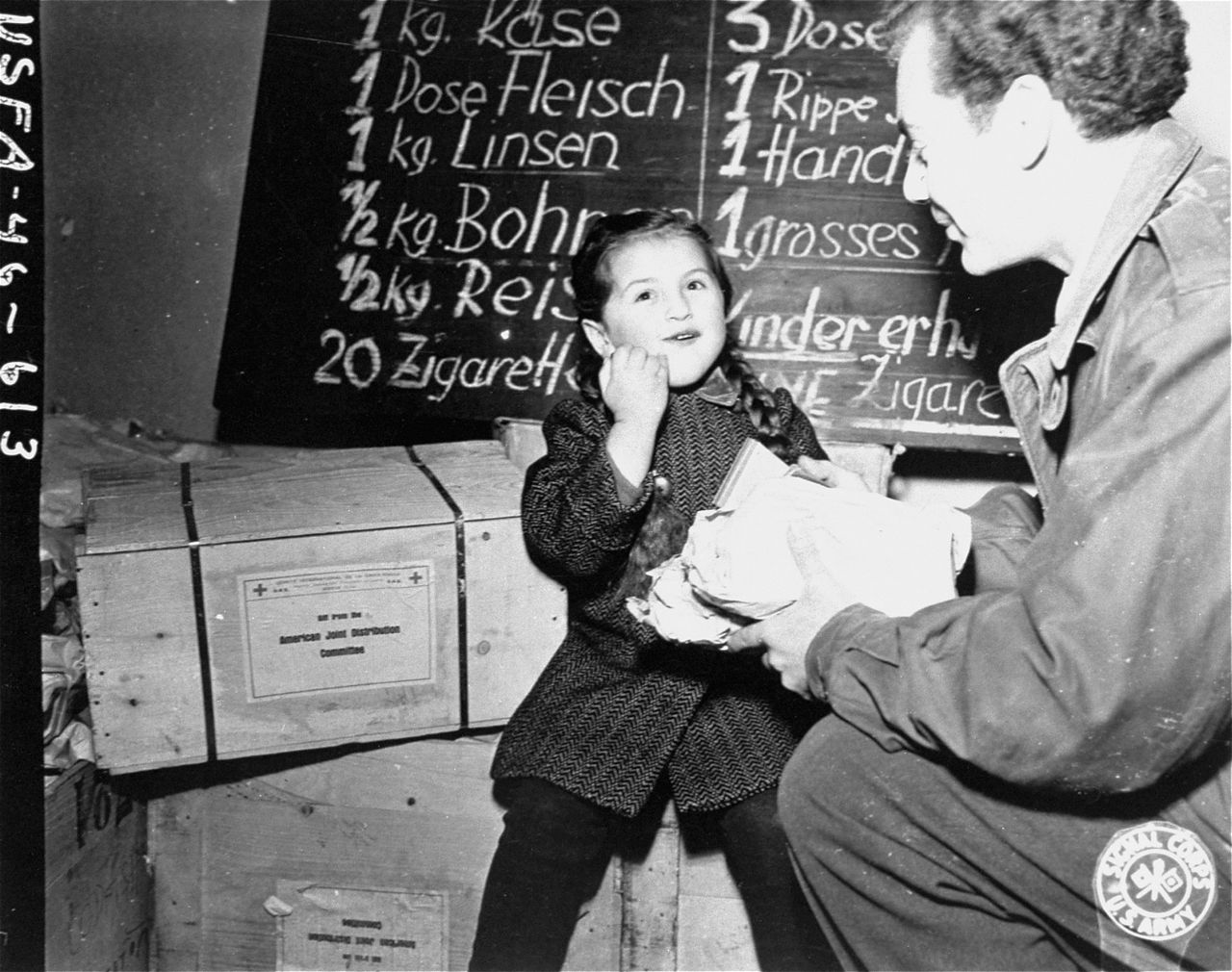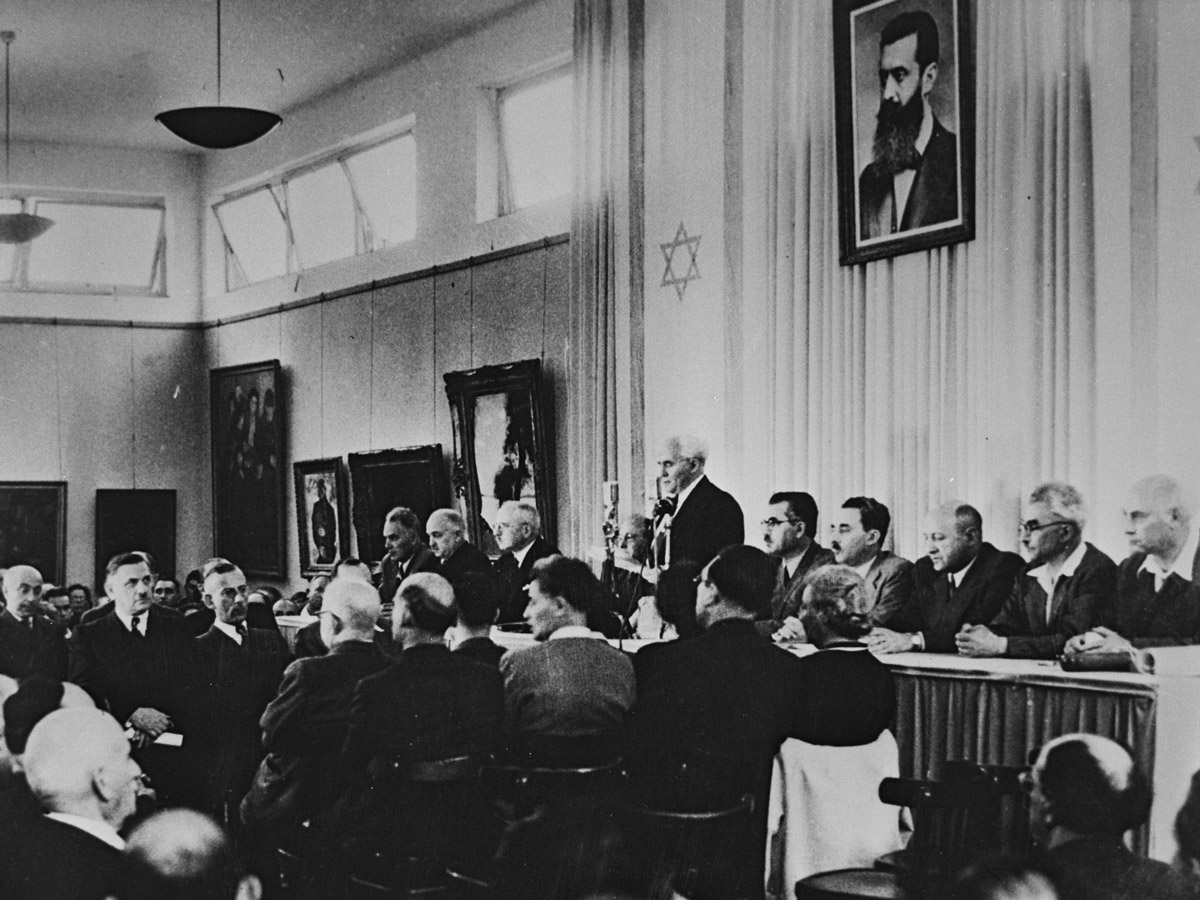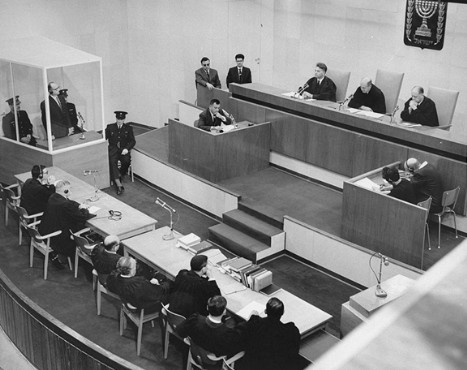1933: Nazi Seizure of Power
Following the Reichstag elections of November 6th, 1932, in which the NSDAP [National Socialist German Workers’ Party – Nazi Party] received 33% of the vote, thereby coming out as the strongest political force, President of the Reich Hindenburg named Adolf Hitler, leader of the NSDAP, as the new Chancellor of the Reich on January 30th, 1933. On the evening of January 30th, 1933, as Nazis celebrated the “Day of the Seizure of Power” with a torchlight procession through the Brandenburg Gate, the triumphant rally also symbolically marked the end of the Weimar Republic. In order to create a government that was exempt from any control by the Reichstag, the Reichstag was disbanded on February 1st, and in the period that followed, the National Socialists neutralized political opponents with violence.
(Source: DHM/LEO)
How did people experience the Nazi seizure of power?
Leo Luster reports:

“After Hitler’s ascension to power in 1933, many Jews from Germany fled to Austria. A few also came to the Polish temple and talked about what was taking place in Germany. My father knew they weren’t making it up. But there were also many Jews that didn’t believe them. They were sure that nothing of the sort would happen in Austria. My father always told us about this at home.”
Learn more about Leo Luster here
1934: February Uprising in Austria
In February 1934, a civil war broke out in Austria. The corporatist constitution was introduced in Austria following the clashes, and Austria developed into an Austrofascist dictatorship. Engelbert Dollfuss, the Federal Chancellor from 1932 to 1934, ruled per emergency decree starting March 5th, 1933 and in 1934 threatened to disarm his opponents – the Schutzbund (Protection League) and the Social Democrats – with violence. Dollfuss had close ties to Italian fascism and the Catholic church, and rejected German National Socialism along with the democratic constitutional state and social democracy. He was murdered during the July putsch of 1934 by Austrian Nazis.
(Source: Stadt Wien/ wien.gv.at)

Soldaten des Bundesheeres vor der Oper in Wien
(Foto: Bundesarchiv unter CC BY-SA 3.0 de)
How did people experience the time of the February Uprising?
Max Tauber reports:

“In February 1934, Dollfuss immediately eliminated everything that was connected to the Social Democrats. The Social Democratic Party was banned, all cooperatives were disbanded, so that my father was not only politically endangered but also economically finished. A noble shoemaker from the inner city – Lakovich was his name – was named chairman of the shoemakers’ cooperative. Shortly after February 12th he wrote my father a letter telling him to come to the cooperative at Floriangasse in the 8th district. There he said to my father, ‘Mr. Tauber, you can immediately take up your position again, but you must join the Fatherland Front.’ That was out of the question for my father and he declined. […] All those who had made themselves politically suspicious were brought to the first Austrian concentration camp in Wöllersdorf. That was nothing more than a prison; it was not to be compared to the German concentration camps. My father then went into hiding at his brother’s and tried to go abroad. He returned to us in the night and left again very early.”
Buchenwald Concentration Camp
Established in 1937, the Buchenwald concentration camp had over 139 satellite camps in which political opponents, Jews, Sinti and Roma, Jehovah’s Witnesses, homosexuals, the homeless, and prostitutes had to carry out forced labor, primarily in the armaments industry. Following the pogrom of November 1938 (Kristallnacht), 10,000 Jews were deported to Buchenwald. From April 6th, 1945, the camp administration began sending inmates on “death marches.” US troops liberated the camp on April 11th. In 1945, Buchenwald was the largest concentration camp in the “German Reich.” More than 56,000 people died there.
(Source: DHM/LEMO)
An excerpt from the last radio address Kurt Schuschnigg made as Austrian Federal Chancellor on March 11th, 1938 with the order given to Austrian forces not to resist the German invasion:
1938: Anschluss – The Annexation of Austria
Following the 1933 NSDAP seizure of power in the German Reich, the Austrian Nazis who had been banned starting in June 1933, also aimed for a takeover of power: During the attempted coup in 1934, Federal Chancellor Dollfuss was killed. Just as Mussolini wanted to secure Austrian independence with Italian troops, the coupists lost the support of Hitler. But by 1938 there was a German-Italian rapprochement that drove Austria into a corner.
In February 1938 Hitler wanted to force an agreement from Federal Chancellor Schuschnigg that would enlist the participation of the Austrian National Socialists in the government. Schuschnigg wanted to avoid this and called for a referendum. Hitler threatened with an invasion of Austria and demanded the surrender of governmental power to the National Socialists, thereby forcing Schuschnigg’s resignation on March 11th, 1938.
On March 12th, German troops marched into Austria and Nazis occupied all important offices. On March 13th, the “Reunification of Austria with the German Reich” was legally put into effect. The Wehrmacht was received jubilantly by the Austrian population, and 100,000 people greeted Hitler on Heldenplatz square in Vienna. One month later, the population voted in an overwhelming majority for the annexation. In the first weeks after the Anschluss, all over Austria – renamed “Ostmark” [Eastern March] – Jews were persecuted and arrested, and many had no choice but to flee.
(Source: DHM/LEMO)
How did people experience the annexation of Austria?
Kitty Suschny reports:

“When the Germans invaded in March 1938, everything was covered in Nazi flags. The flags were already hanging the day before. There was a woman in our neighborhood who couldn’t even speak correct German. She would always cry out, ‘Let’s hear it for German Vienna!’ But you can’t say that all Austrians were Nazis. I only say that with rage because there were a lot. There was also a lot of unemployment at that time, and so much poverty because of it.”
Kurt Rosenkranzreports
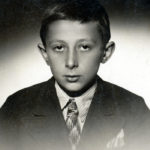
“We were a boys’ class, and a few days prior to the German invasion, in March 1938, I was still playing soccer with my non-Jewish classmates in the street. On Friday evening Hitler marched in. We were at my grandparent’s place, it was Shabbat. All of a sudden we heard on the radio, ‘God save Austria!’ Those were Schuschnigg’s last words, and my mother wept bitterly because she knew what was coming. It had no effect on me. But on Saturday morning, the looting began in Vienna.”
Lucia Heilman reports:

“Then Hitler came in 1938. When Schuschnigg gave his speech on the evening of March 11th, 1938 we had a radio and my mother listened to the speech and was very distraught. On March 12th German troops marched into Austria. I was eight years old and went by myself to Heldenplatz square, since there was an event there. As I reached the vicinity of Heldenplatz square I couldn’t go any further – there were so many people on the Ring Road. I stood there and heard the yells, the roaring, and this cry, ‘Heil, Heil, Heil…’ and I knew that I didn’t belong there. I found this atmosphere very threatening. I stood there for a while and saw people climbing trees so they could get a better look. And the cries didn’t stop. Then I came home completely distraught.”
Paul Back reports:
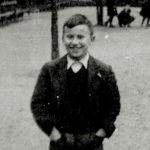
“On March 12th, 1938 I saw airplanes black out the sky, a whole host of airplanes, real squadrons. You began seeing people in uniform and boys in Hitler Youth shirts walking around. […] New teachers arrived to school. Among them was a Sudeten-German, a Nazi, who didn’t hide his ideology and immediately hung up the new maps.”
Leo Luster reports:

“I can still remember March 11th, 1939 like it was today. I was with my father in the synagogue on Friday evening. A neighbor stopped us on our way home from the synagogue: ‘Something terrible has happened. Chancellor Schuschnigg stepped down.’ I can still remember his words exactly: ‘Now our bad luck begins.’ And that’s what it was! On Saturday people were already walking around the streets with swastika bands, looking for Jews. My father immediately lost his job after the German invasion. The Germans had already filled the government functions with their people and took over the police. They knew exactly who lived where. They took everything from the Jews and soon there were no more Jewish businesses,”
Learn more about Leo Luster here
Kitty Schrott reports:
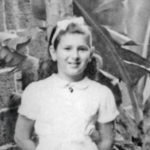
“In the year 1938, after the Germans had invaded Austria, we had to move from Laa to Vienna, since Jews from the provinces were being gathered in Vienna. […] At first we, my paternal grandparents, my maternal grandmother, my Uncle Ernst and my Uncle Alexander, lived in the 2nd district on Praterstrasse, very close to the entrance to Czerningasse.”
Max Uri reports:
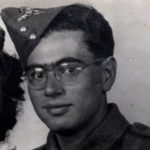
“I can still remember the German invasion of Austria in March 1938 well. We were living in a good neighborhood, and in the evening we heard on the radio Chancellor Schuschnigg resign. We turned off the light in the living room. Not far from our apartment, on Karl-Lueger-Platz square, the mob raged against the Jews. Shortly thereafter I had to leave the vocational college; as a Jew I was no longer allowed to study.”
1938: Night of Broken Glass/Kristallnacht
During the night of November 9th and into the morning of November 10th, 1938, the so-called “Reichspogromnacht” (Reich pogrom night – also known as the Night of Broken Glass) took place in which nearly all synagogues and 7,500 Jewish shops were destroyed and looted throughout the “German Reich.” The actions were organized by Minister of Propaganda Goebbels and was referred to by the Nazis as “Kristallnacht” (Crystal Night).
In Vienna, 49 synagogues and prayer houses were almost completely destroyed by grenades and fire. Only the synagogue on Seitenstettengasse remained undamaged as there was fear that the fire could endanger the surrounding apartment buildings. Following Kristallnacht, deportations rapidly increased, all Jewish organizations were forbidden, and the rights of Jews were further restricted.
Source: United States Holocaust Memorial Museum
Private film clip from Vienna, likely taken directly after Kristallnacht 1938 (Source: Prelinger Archives/Wikimedia Commons, Public Domain)
How did people experience Kristallnacht?
Max Uri reports:

“On November 10th, during the pogrom night, three SS men entered the store and demanded the shop keys. Moses Zwick did not want to give away the shop keys. They knocked out all of his teeth, took the keys from him, and he wasn’t allowed to enter the store again. That was the end of the company ‘Uri & Zwick.’”
Max Uri reports:

“On November 10th, 1938 I was arrested and detained in the 9th district in a riding school on Pramer-Gasse with around a thousand other Jews, some of whom had been taken from their homes in pajamas or undergarments. Around 3 in the morning those under 18 and over 60 years of age were allowed to go home. A mob had gathered outside and was waiting for us. A high-ranking police officer was prepared to protect us, but only for as long as it took him to count to ten. I ran, which luckily was easy for me as an athlete. That night my mother had hidden herself with my sisters and brother at her sister-in-law’s, my Aunt Rosa Roth. […] After the pogrom night, taxes were imposed on Jews, such as the Reich Flight Tax and the Judenvermögensabgabe (Jewish Property Tax)”
Leo Luster reports:

“On November 10th, 1938, after the pogrom night, so-called “Kristallnacht,” my father was arrested and detained. Our apartment was on the third floor. In our building there was a basement apartment without light, without electricity, water, and a toilet. A man lived in this apartment, an illegal Nazi. He came up and told us we had to evacuate our apartment. When he came, only my sister and I were at home. We needed to get our things out of the apartment – that which we could carry – and go to the basement. When my father was let out he was pretty beaten up and told us why. They told him he couldn’t tell anyone about his experience. They had beaten and tortured the people in the prison.”
Learn more about Leo Luster here
1933-1945: Dachau Concentration Camp
In 1938, over 7,800 Austrians were deported to the Dachau concentration camp in Munich. The first transport – also called the Prominententransport (Prominent Transport) – arrived to Dachau three weeks after the Anschluss in April 1938: This transport was comprised of representatives of the corporatist state, political functionaries, police and judiciary functionaries, along with Jews, Socialists, and Communists.
Following Kristallnacht in November 1938, many Jews from Vienna were deported to the Dachau concentration camp. After the start of the Second World War, people from occupied territories throughout Europe were also detained in Dachau. Around 41,500 of the at least 200,000 Dachau inmates died.
Source: DHM/LEMO
Kindertransports
As a result of Kristallnacht, which took place from the 9th to the 10th of November, 1938, Great Britain decided to bring 10,000 Jewish children from Germany, Austria, and later also Czechoslovakia to Great Britain to protect them from persecution and deportation.
On December 2nd, the first Kindertransport (Children’s Transport) reached the British harbor of Harwich from Berlin. The Kindertransports from the German Reich ended with the outbreak of the Second World War on September 1st, 1939. Ultimately, around 10,000 children were saved by the Kindertransports.
Source: United States Holocaust Memorial Museum
How did people experience the Kindertransports?
Kitty Suschny reports:

“There were 1,000 of us back then; it was already the second Kindertransport to England. My mother said, ‘Don’t go to England, go to Holland! You can walk back from there. Take a handcart and a farmer will give you a ride for part of the way or you can walk home. You won’t be able to get across the water.’ My mother, Mrs. Maurer, Mr. Maurer, and little Heinz said goodbye to us in Hütteldorf [14th district] at 11:30PM. There were also nurses there from the Rothschild Hospital on the transport. They youngest child was six weeks old. […] You weren’t allowed to give anything to the children so that the transport wasn’t jeopardized, god forbid. That was strictly forbidden. You could officially take ten marks, so we had very little money. But Ilse had hidden jewelry and some money. I learned that after only we’d arrived in England.”
1939: Start of the Second World War
The start of the Second World War began on September 1st, 1939 when Poland was invaded by the German Reich. More than 60 million people were killed during the Second World War, including six million Jews – the majority of the Jewish population of Europe. The war ended in in 1945.
How did people experience the start of the Second World War?
Irene Bartz reports:

“In September 1939, a few days after the German attack on Poland, my mother was arrested and imprisoned. Vera and I were sent to my father’s sister, so that the Poles couldn’t find us. One week later, we had to pack a few things and were taken by train to the Russian-Polish border. My father’s sister, my beloved grandfather, and Aunt Amalia stayed behind in Krakow. Our train was bombed and we had to keep getting on and off. We were taken to a Ukrainian village.”
Learn more about Irene Bartz here
1939: Molotov-Ribbentrop Pact
The Molotov-Ribbentrop Pact, the name for the German-Soviet non-aggression pact, was signed in Moscow on August 23rd, 1939 by German Foreign Minister von Ribbentrop and Soviet Foreign Minister Molotov. In an additional, secret protocol, the countries determined the division of northeastern and southeastern Europe in the case of a “territorial transformation.” The partition of Poland was at the center of this protocol.
Source: DHM/LEMO
Irene Bartz reports:

“The war was over for us for the time being, because the Russians and Germans had divided Poland. The border was the San River and we were in Korstopol, in the Russian section. But the Ukrainians who lived there told us every day that they were going to kill us because we were Jews.”
How did people experience the signing of the Molotov-Ribbentrop Pact?
Kurt Rosenkranzreports

“In [1939], Hitler and Stalin signed the Molotov-Ribbentrop Pact. The Russians occupied Riga. We went to the train station and saw Red Army soldiers disembarking from cattle cars from the Finnish front. People were coming out of cattle cars, it was horrible.”
1941: German Invasion of the Soviet Union
On June 22nd, 1941, the German Reich invaded the Soviet Union, despite the non-aggression pact. This invasion – given the codename “Operation Barbarossa” by the Wehrmacht – lead to war between Nazi Germany and the Soviet Union, which only ended with the capitulation of Germany in May 1945. At first, the German Reich gained a lot of territory, with troops stationed just outside Moscow. German soldiers murdered millions of civilians as part of the war of annihilation waged by the Wehrmacht. The Battle of Moscow at the end of 1941 and the Battle of Stalingrad in 1942/43 in particular signaled the decisive turning point and gave the Soviet Army the upper hand. Today, the war is referred to as the “Great Patriotic War” in Russia.
Source: United States Holocaust Memorial Museum
How did people experience the German invasion of the Soviet Union?
Kurt Rosenkranzreports

“Then came the 22nd of June, 1941 – the outbreak of war! At around four in the morning there was a knock at the door. A Red Army soldier was standing outside. He said we were to pack up and be done in five minutes. That came to us as a total surprise. I showed the Red Army soldier my ‘Pioneer Chief’ identification. He threw it on the ground and stomped on it. From that moment on, Communism was dead to me. Since we were German citizens and considered potential spies, we were imprisoned. It didn’t matter that we were Jews. We were interned in the French Lyceum in Riga, experienced three German air raids and, after several days, were thrown onto freight cars.”
Irene Bartz reports:

“To us, the Germans were still a cultivated people, although one should have known more. On June 30th, 1941, the Germans occupied Lwów [Lviv. Today: Ukraine]. At night, the Russians were standing outside our door and said that we had to pack. We were taken from Lwów to the Urals.”
Theresienstadt Ghetto
The Theresienstadt ghetto-camp existed between November 1941 and May 1945. Of the around 140,000 imprisoned Jews, nearly 90,000 were deported to Auschwitz and other extermination camps. Around 33,000 died in Theresienstadt as a result of the horrific living conditions.
Source: United States Holocaust Memorial Museum
How did people experience Theresienstadt?
Paul Back reports:

“We didn’t know anything about my grandmother who had stayed in Vienna. We only learned about her fate after the war. She was thrown out of the apartment where she had spent 20 years of her life. Then she lived in one of these collective apartments in Vienna’s 2nd district and from there she was deported first to Theresienstadt and then to Treblinka, where she was murdered.”
Learn more about Paul Back here
Leo Luster reports:

“I had the good fortune of having a father who worked for the Jewish Community – because of this we weren’t deported to Poland, but rather to Theresienstadt. […] We were on the train for two days with over a thousand people. Then we arrived in Bauschowitz [Bohušovice. Today: Czech Republic]. We had to walk to the ghetto. […] We lived together at first; that was in an attic. It was horrible. We had nothing. My father lived in the Sudeten barracks and my mother was given a different place with other women. But they could meet every day.”
Auschwitz / Birkenau
The concentration and extermination camp Auschwitz was divided into three camps. The construction of Auschwitz I, which served as the main camp, was ordered by Himmler on April 27th, 1940. In March 1941 the complex was expanded with the addition of the Birkenau extermination camp, the function of which was the industrialized annihilation of human beings. For this purpose, the National Socialists primarily used gas chambers to kill people and afterwards burned them in the crematoria.
Alongside numerous other labor camps (e.g. Gleiwitz), the camp Auschwitz III, often referred to as the Monowitz labor camp, was established close to the city of Oswiecim. Because of the difficulty in investigating the victims (many were murdered immediately without registration), an exact number of victims is unknown. At least 1.1 million have been confirmed, although other historians estimate up to 1.5 million. Auschwitz has become the synonym for the mass murder of European Jews.
Neben zahlreichen anderen Arbeitslagern (u.a. Gleiwitz), wurde auch das Lager Auschwitz III nahe der Stadt Oswiecim errichtet, das auch oft Arbeitslager Monowitz genannt wird. Aufgrund der schwer ermittelbaren Opfer (viele wurden ohne Registrierung direkt ermordet) ist eine genaue Zahl an Todesopfern nicht vorhanden. Mindestens 1,1 Millionen gelten als gesichert, wobei andere Historiker von bis zu 1,5 Millionen ausgehen. Auschwitz wurde zum Synonym für den Massenmord an den europäischen Juden.
How did people experience the Auschwitz concentration camp?
Leo Luster reports on his arrival to Auschwitz:

“Our whole group that was living together remained together and was then on the same transport to Auschwitz. My father was also there. I didn’t know what was going on with my mother. […] We had to stand in five rows – the whole transport, a thousand people in five rows – on the platform. […] I saw the SS man pointing to one side or to the other. The older people went to the left side, the younger people to the right side. […] When it was my turn, the SS man asked me how old I was and what my profession was. ‘Electrician,’ I said. I had to go to the right. We didn’t understand what was even happening. I didn’t know where my father was. I lost sight of him. A few hours later I saw the crematorium and the fire.”
Irene Bartz reports:

“I found out that my grandfather and Aunt Amalia had been deported to the Auschwitz concentration camp. That was the end of my beloved grandfather and my aunt. […] I only knew that Papa had managed to get to the south of France from Vienna. They must have arrested him there, since he was deported on August 12th, 1942 from Drancy, a collection camp near Paris, to Auschwitz and murdered.”
Leo Luster reports on everyday work:

“Prisoners told us that you needed a tattooed number in order to survive Birkenau. If you didn’t have a number, you weren’t worth anything. We were six friends and were all sought out for work. They gave us better clothes and we got a number tattooed on our arm. That meant we were people. We received blankets, were brought to the train, and rode from Birkenau to Gleiwitz [Gliwice, Poland]. They took us to a factory where they repaired railway cars. It was terribly cold. We worked six days a week. On the seventh day we had to carry stones from a spot that was one kilometer away into the camp, and then carry them back! That was so we couldn’t relax.”
Learn more about Leo Luster here
Maly Trostenets Extermination Camp
Maly Trostenets was a concentration camp established by Nazi Germany close to Minsk in what is today Belarus, where tens of thousands of Jews were murdered. Of the 9,000 Jews from Austria who were brought to Maly Trostenets between May and October 1942, only 17 survived.
Source: DÖW/ Documentation Centre of Austrian Resistance
Death Marches
On April 14th, 1945, SS Reich Leader Heinrich Himmler gave the order that no concentration camp inmate would be allowed to fall into the hands of the steadily approaching Allied troops alive. He ordered the evacuation of the labor and death camps along the front. The prisoners were to be taken primarily from the Eastern Front, which the Red Army had by then breached throughout, into the interior of the country – into other camps or remote areas. Thousands of prisoners died during these agonizing death marches.
Source: USHMM
How did people experience the death marches?
Leo Luster reports:

“We found a few newspaper sections in the train cars and read that the Russians were outside Warsaw. Suddenly we received the command that we weren’t to go to work. Everyone got half a piece of bread, a can of black pudding, a bit of margarine and jam. We had to march. That was a death march. SS men accompanied us the whole time. It was still winter. We had no warm clothes and bad shoes. We walked… where to? We didn’t know. We walked the whole day; many kilometers. They shot whoever stayed back. We weren’t given anything to eat. After three days we reached Blechhammer [Blachownia Śląska, Poland], a satellite camp of the Auschwitz concentration camp.”
Learn more about Leo Luster here
1945: Liberation of Auschwitz
The Auschwitz-Birkenau concentration and extermination camp was liberated by the Soviet Army on January 27th, 1945. Prior to this, the SS forced 60,000 inmates on so-called death marches that were to take them further to the west and away from the front. They also set fire to many of the barracks and buildings and murdered thousands of people before clearing out the camp. Today, the 27th of January is an international remembrance day for the victims of National Socialism.
Source: State Center for Political Education Baden-Württemberg
1945: Capitulation of the German Reich
After Soviet Troops had reached Berlin in April 1945 and American troops were approaching, Adolf Hitler took his life on April 30th, 1945. Berlin had fallen and in May the High Command of the Wehrmacht, Army, Luftwaffe, and Navy signed the unconditional surrender. To this day, May 8th is considered to be the end of war in Western Europe, and in Russia May 9th (due to the time difference).
Source: USHMM
Video: England celebrates the victory over Nazi Germany (Source: AP ARCHIVE)
How did people experience the end of the war?
Kurt Rosenkranzreports

“After the war we hoped to be set free. We were told that we still had to gather in the harvest, and then we’d be allowed to go home. The harvest was inside; we didn’t go home. At the end of December 1946, in the middle of a snowstorm, trucks came to pick us up. We were riding in cattle cars, but we were free.”
Leo Luster reports:

“The war was over on May 8th. The Russians came to us and said, ‘go wherever you please. You are free!’ By chance we learned there were still people in Theresienstadt. I hadn’t anticipated that. Typhus had broken out in the camp. There I met a friend of my fathers. He said to me, ‘Have you already been to your mother’s? I saw her, she is here!’ I don’t know if you can imagine how that was for me. I found her in an attic. Can you imagine that? The first question she asked me was, ‘where is dad?’ I couldn’t say anything and she only said, ‘God has bestowed this upon me, you being alive.’”
Learn more about Leo Luster here
Lucia Heilman reports:

“On April 13th, Reinhold came and collected us. He had seen Russian soldiers. We left our hiding place very carefully and full of fear and saw Russian soldiers marching down Gumpendorfer Strasse. Thousands… it was madness! It’s a feeling you can’t describe, how the Russians came and I was finally freed. I was happy, I was blessed, I could finally run where I wanted, and I could sit on every park bench.”
Learn more about Lucia Heilman here
Displaced Person Camps (DP-Camps)
Displaced Persons, or DPs for short, is the term used to describe the surviving victims of the Nazi regime. The majority came from Poland, Hungary, Lithuania, Russia, Ukraine, or Romania. Most of them no longer had a home, family, or sustenance.
After the Allied invasion from 1945 to 1952, there were between 6.5 and 7 million DPs living in the territory of the former “German Reich,” 250,000 of whom were Jews. They lived in camps in Allied-occupied Germany, Austria, and Italy, and were managed by the UN (United Nations Relief and Rehabilitation Administration, UNRRA). Most of the camps were disbanded between 1949 and 1951, when, following Israel’s war of independence and the easing of US immigration policy, most of the Jewish DPs were able to emigrate.
Source: USHMM
How did people experience the DP camps?
Leo Luster reports:

“The Americans helped us a lot. We got the chance to travel to Bavaria. That’s how we arrived to the Displaced Persons camp in Deggendorf. There were old Wehrmacht barracks in Deggendorf. They set up a camp there. We had a very nice time in Deggendorf. We stayed there for four years. I began to work, initially for the aid organization UNRRA – the United Nations Relief and Rehabilitation Administration and later for the Joint [American Jewish Joint Distribution Committee – a US-American Jewish aid organization]”
1948: Founding of Israel
After the end of the Second World War and the Shoah, which claimed six million Jewish victims in Europe, international support for the Zionist movement grew. In November 1947, the UN general assembly decided to divide the territory of Palestine into an Arab and Jewish state, in which 1.3 million Arabs and 608,000 Jews were living.
The British Mandate for Palestine ended on May 14th, 1948 and British troops withdrew. Thereafter David Ben-Gurion proclaimed the Declaration of Independence in Tel Aviv. The USA and Soviet Union gave the Israeli state diplomatic recognition on the same day, however Egypt, Saudi Arabia, Jordan, Lebanon, Iraq, and Syria declared war against Israel, which Israel nevertheless won.
Source and further information: Federal Agency for Civic Education
How did people experience the founding of Israel?
Lizzi Granierer reports:

“Once the State of Israel was proclaimed in 1948, I had to register with the military. I said that they should only take me as reserve, since I was working at Kolbo and had to help my siblings and parents. I would come if they needed me, but not now. They accepted this and I was exempt.”
Leo Luster reports:

“The State of Israel was proclaimed in 1948. In 1949 my mother and I left for Marseille. From there we traveled by ship to Haifa. That was the first time either of us had ever seen a ship with an Israeli flag. We even had cabins and were given food. That was a terrific journey! The voyage took around five days. On the last night we danced; everyone wanted to see Haifa as it appeared. At around five in the morning we saw the lights on the coast. That was a great moment – it was incredible!”
was. I lost sight of him. A few hours later I saw the crematorium and the fire.”
Learn more about Leo Luster here
Max Tauber reports:

“In November 1947 the United Nations decided that Palestine would be divided into a Jewish and Arab state. From that moment on, Jerusalem was a fortress. You couldn’t go in or out because it was surrounded by Arab settlements. […] Jerusalem was completely closed starting in February 1948. British troops had put an armored train on the railway line, since the British left the country.”
Paul Back reports:

“In 1945/46 there was already a movement for the founding of an independent Israeli state. It started with actions and demonstrations for free immigration. There was a lot of pressure after the war once the scale of the destruction became known, and many Jews wanted to get into the country but were sent back because the English wanted to limit free immigration. There was already a state within a state with Jewish institutions – they called it ‘medina baderech,’ which, when translated, means ‘a state becoming.’ But people wanted a completely autonomous Jewish state. […] By the time the state of Israel was founded I was already with the ghost army, as we were already mobilized and organized even before there was a state and army. In 1948 we were already in the middle of war.”
Learn more about Paul Back here
1961: The Eichmann Trial
On December 15th, 1961, the trial against Adolf Eichmann ended in Israel: the organizer of the Nazi extermination of the Jews was sentenced to death. As the director of the Reich Central Office for Jewish Emigration and division head for Jewish affairs at the Reich Main Security Office, Adolf Eichmann was significantly involved in the Holocaust.
After the war he fled to Argentina, where he was caught by Israeli agents in 1960. In 1961 the trial against him began in Israel, which ended with a death sentence in 1962. The entire world followed the trial and it provoked a process of coming to terms with the Holocaust and Nazi crimes.
Source: Federal Agency for Civic Education
How did people experience the Eichmann trial?
Leo Luster reports:

“Back then we had little contact with the Sabras, the people who were born here. We were cowards in their eyes. ‘Why didn’t you defend yourselves? You went like sheep to the slaughter.’ They couldn’t understand. They looked down on us. They weren’t the least bit interested in our stories. They didn’t understand what really happened. Only in 1961, during the Eichmann trial, did they begin to understand us. […] I had the opportunity to be at the Eichmann trial for a day. I had a good view of him on that day of the trial. He sat in his booth. They were afraid someone was going to shoot him. A German lawyer defended him. But it didn’t help him. Eichmann is the only person to have been hanged in Israel.”
Learn more about Leo Luster here
1967: Six-Day War
The Six-Day War was essentially the continuation of the 1948/49 Israeli war of independence, as the goal of the Arab neighbors had remained the same: the destruction of the Jewish state. The catalyst for the war was the Egyptian blockade of the Straights of Tiran for Israeli shipping, Egyptian President Nasser’s forced withdrawal of UN troops from Sinai, and an Egyptian deployment of 1,000 tanks and nearly 100,000 soldiers on the border to Israel.
The war began on June 5th, 1967 with an Israeli preventative attack against Egypt that was to preempt an attack of Arab states. Jordan, which had formed a defense pact with Egypt on May 30th, 1967, subsequently attacked West Jerusalem, Ramat Rachel, and Netanya. The war ended on June 10th, 1967 with the defeat of Egypt, as well as that of the United Arab Republic, Syria, and Jordan. Israel won control of the Gaza Strip, the Sinai Peninsula, the Golan Heights, the West Bank, and East Jerusalem.
Source: Federal Agency for Civic Education
How did people experience the Six-Day War?
Paul Back reports:

“A war-like situation continued after the Six-Day War. There was the War of Attrition between Israel and Egypt, which lasted for years and touched every citizen, as everyone had to do their auxiliary service in the army each year. In 1973 Egypt attempted to storm the Suez Canal and Sinai Peninsula, along with recapturing the Gaza Strip. The ‘Yom Kippur War’ took the whole country by complete surprise. People couldn’t grasp it.”
Learn more about Paul Back here
